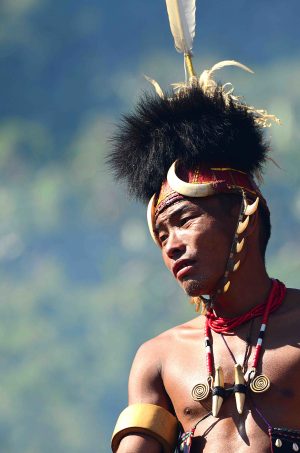Northeast India, the region of India that lies mostly east of Bangladesh and west of Myanmar, is distinct among the areas of India. For a start, it is connected to the rest of India by the narrowest of corridors, the Siliguri Corridor, which is 20 kilometers (12 miles) in some places.
But its distinguishing features are not merely geographic, but sociocultural. Much of Northeast India is culturally distinct from the rest of India, and many of its peoples were not incorporated into states until the British colonial era. As a result, the region is characterized by ethnic heterogeneity. Outside of the Brahmaputra River Valley of Assam, where wet-rice cultivation aided in the formation of larger, more-centralized polities, it is a kaleidoscope of tribal groups that have not been homogenized by states. The result is a modern tinderbox of competing tribal, ethnic, religious, and political claims that often erupt into violence, as most recently seen in the state of Manipur. How did Northeast India come to be this way?
James C. Scott, an anthropologist who specializes in Southeast Asia, describes the highlands of Northeast India, Southeast Asia, and Southwest China using a concept called “Zomia.” Zomia, which consists of the land above 300 meters in this region, is “the largest remaining region of the world whose peoples have not yet been fully incorporated into nation-states.” According to Scott, this was by design, as tribal people wished to practice “state avoidance.” Elaborating on this in his book, “Art of Not Being Governed,” Scott says that these hill tribes are “best understood as runaway, fugitive, maroon communities who have, over the course of two millennia, been fleeing the oppressions of state-making projects in the valleys — slavery, conscription, taxes, corvée labor, epidemics, and warfare.”
Yet, even the ethnic demographics of Zomia were not static across time, and many of the migrations of various tribes or the expansion of neighboring states are the precursors of today’s tensions in Northeast India.
The edge of classical Indian civilization lay in modern Bengal and the westernmost part of modern Assam for centuries. For much of the first millennium of the common era, the Kamarupa Kingdom was situated here as a frontier territory. East of it lay hills, forests, and swamps settled by people originating in Southeast Asia and China. This was in sharp contrast to the rest of India, into which people have historically usually migrated or invaded from the northwest. Some of the earliest migrants in Northeast India were people who spoke Austroasiatic languages, a family that includes Khmer and Vietnamese. In the Northeast, they are represented by the Khasi people of Meghalaya state. These people may have specialized in dry rice farming in hills. They were followed by various Tibeto-Burman people migrating in several waves, as well as other ethnicities, like the Tai Ahoms. These people all originated in Southeast Asia and modern China, and formed several distinct branches of Tibeto-Burman peoples.
Some, such as the Bodo and Garo who lived in northwest Assam and Meghalaya respectively, seem to have arrived before a later wave of Kuki-Chin-Naga people. Some Tibeto-Burman peoples developed small states and gradually adopted Hinduism, including the Twipra of Tripura, the Ahom of Assam — who eventually conquered and assimilated Kamarupa — and the Meitei of Manipur. Other groups remained as tribes in the hills and resisted the encroachment of states, including the Naga, and the closely related Kuki, Mizo, and Chin peoples. These groups, speaking a plethora of languages, remained a patchwork of competing groups when the British colonized the region.
Whether the tribes of Northeast India made a conscious decision to remain outside of the system of surrounding Hindu and Buddhist states or whether this separateness is a function of ecology and geology, much of northeastern India and neighboring areas of Southeast Asia remained inhibited by non-state tribal groups like the Naga, Kuki, Mizo, Chin, Kachin, and Karen. These groups remained fiercely independent; even during the British period, these hill tribes mostly converted to Christianity and resisted assimilation into the cultures of more numerous neighbors such as the Bengali, Assamese, and Burmese.
Independent India inherited the Northeast — much of which was initially part of the state of Assam — with its sociopolitical structure of independent-minded hill peoples interspersed with state-like structures in the lowlands. Manipur, which was a princely state that later acceded to India in 1949, had its own dichotomy between lowland Meitei and highland Kuki and Naga people. For much of India’s post-independence period, the Northeast has seen chronic rebellion, independence movements, and ethnic violence, almost always driven by the same underlying concern: the desire of a people to maintain their identity, avoid assimilation, and push back against encroachment by other groups. Hence, the violence in the last decade alone between Bodos and Bengalis, Bru and Mizos, and now Kukis and Meitei. That is why Assam has been partitioned multiple times to create the new states of Nagaland, Mizoram, Arunachal Pradesh, and Meghalaya; given its ethnic makeup, it may yet spawn several more states such as Bodoland. Now, the Kukis of Manipur are demanding another state. It would not be surprising if the ultimate solution to the Northeast’s ethnic turmoil is its division into a dozen more ethnic states.

































